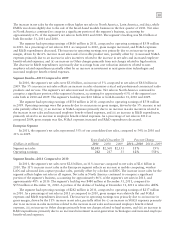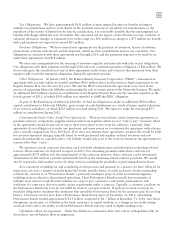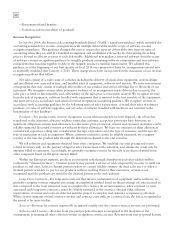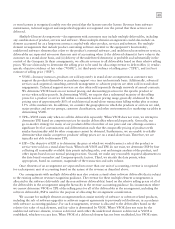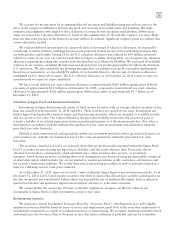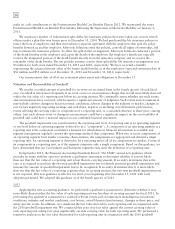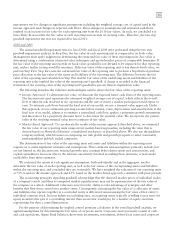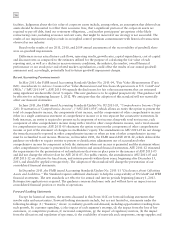Motorola 2011 Annual Report Download - page 54
Download and view the complete annual report
Please find page 54 of the 2011 Motorola annual report below. You can navigate through the pages in the report by either clicking on the pages listed below, or by using the keyword search tool below to find specific information within the annual report.
48
—Retirement-related benefits
—Valuation and recoverability of goodwill
Revenue Recognition
In October 2009, the Financial Accounting Standards Board (“FASB”) issued new guidance which amended the
accounting standards for revenue arrangements with multiple deliverables and the scope of software revenue
recognition guidance. This guidance changed the criteria required to separate deliverables into separate units of
accounting when they are sold in a bundled arrangement and established a hierarchy for determining the selling
price to be used to allocate revenue to each deliverable. Additional new guidance removed software from the scope
of software revenue recognition guidance for tangible products containing software components and non-software
components that function together to deliver the tangible product’s essential functionality. We adopted this
guidance as of the beginning of our first quarter of fiscal 2010 on a prospective basis for arrangements entered into
or materially modified after January 1, 2010. These changes have been incorporated in the discussion of our revenue
recognition policies that follow.
Net sales consist of a wide range of activities including the delivery of stand-alone equipment, custom design
and installation over a period of time, and bundled sales of equipment, software and services. We enter into revenue
arrangements that may consist of multiple deliverables of our product and service offerings due to the needs of our
customers. We recognize revenue when persuasive evidence of an arrangement exists, delivery has occurred, the
sales price is fixed or determinable, and collectability of the sales price is reasonably assured. We recognize revenue
from the sale of equipment, software bundled with equipment that is essential to the functionality of the equipment,
and most services in accordance with general revenue recognition accounting guidance. We recognize revenue in
accordance with accounting guidance for the following types of sales transactions: (i) standalone sales of software
products, (ii) sales of software upgrades, and (iii) sales of software bundled with hardware not essential to the
functionality of that hardware.
Products—For product sales, revenue recognition occurs when products have been shipped, risk of loss has
transferred to the customer, objective evidence exists that customer acceptance provisions have been met, no
significant obligations remain and allowances for discounts, price protection, returns and customer incentives can be
reliably estimated. Recorded revenues are reduced by these allowances. We base our estimates of these allowances
on historical experience taking into consideration the type of products sold, the type of customer, and the specific
type of transaction in each arrangement. Where customer incentives cannot be reliably estimated, we recognize
revenue at the time the product sells through the distribution channel to the end customer.
We sell software and equipment obtained from other companies. We establish our own pricing and retain
related inventory risk, are the primary obligor in sales transactions with customers, and assume the credit risk for
amounts billed to customers. Accordingly, we generally recognize revenue for the sale of products obtained from
other companies based on the gross amount billed.
Within our Enterprise segment, products are primarily sold through distributors and value-added resellers
(collectively “channel partners”). Channel partners may provide a service or add componentry in order to resell our
products to end users. Sales to channel partners where we cannot reliably estimate the final sales price or when a
channel partner is unable to pay for our products without reselling them to their customers, revenue is not
recognized until the products are resold by the channel partner to the end customer.
Long-Term Contracts—For long-term contracts that involve customization of equipment and/or software, we
generally recognize revenue using the percentage of completion method based on the percentage of costs incurred to
date compared to the total estimated costs to complete the contract. In certain instances, when revenues or costs
associated with long-term contracts cannot be reliably estimated or the contract contains other inherent
uncertainties, revenues and costs are deferred until the project is complete and customer acceptance is obtained.
When current estimates of total contract revenue and contract costs indicate a contract loss, the loss is recognized in
the period it becomes evident.
Services—Revenue for services is generally recognized ratably over the contract term as services are performed.
Software and Licenses—Revenue from pre-paid perpetual licenses is recognized at the inception of the
arrangement, presuming all other relevant revenue recognition criteria are met. Revenue from non-perpetual licenses



